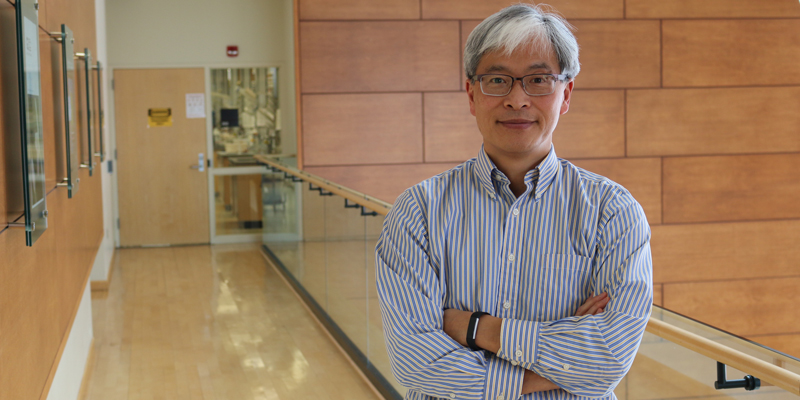This longtime member of the Plant and Microbial Biology faculty is interested in what makes plants' immune signaling networks resilient.

Much like humans, plants exhibit immune responses to invading pathogens. Unlike us, plants don’t have options to run away from problems or quarantine affected individuals, so plants need to heavily rely on their immunity to deal with pathogens. Since unnecessary immune responses carry strong negative impacts on fitness of plants, ideally immune responses should be turned on only when needed and only at the minimum level necessary. This task becomes complicated because pathogens interfere with plant immune signaling, and microbial pathogens can evolve much faster than plants. Plants employ a surprisingly resilient immune signaling network that is able to relay information about pathogen attacks within cells and to neighboring cells, tissues, and even other plant individuals. The network components are well buffered, meaning if one component of the network is disabled by a pathogen, other components will carry on its functions and the plant will maintain a strong immune response. Using the model organism Arabidopsis, Fumiaki Katagiri investigates how plant immune networks are able to pull off this useful feat.
What do you envision for your research program in the future?
I’m very interested in the mechanisms and dynamics that enable resilience and ‘tunability’ of the signaling network. We are elucidating individual functions of and relationships among the subnetworks by disabling multiple subnetworks at once in various combinations. I hope to eventually engineer the dynamical state of the network: if pathogens have never seen a particular state of the network through their evolution, it may limit their ability to evolve new methods of attack. Another thing I’d like to study is how such a resilient network evolved. We have a pretty good idea of when it happened, right at the beginning of the angiosperm lineage, but how it came to contain so many buffering mechanisms is something I’d like to explore further. The acquisition of resilient immunity could be one of the reasons that angiosperms have been so successful, but I’m not sure how to test this idea.
Gymnosperms don’t have the same sort of resilience built into their immune response network?
Most of what we know about the signaling network is in regard to Arabidopsis. We trace back to when particular protein subfamilies important for resilience of the Arabidopsis immune signaling network began to evolve within the larger protein families. Some of the protein subfamilies began to evolve before the ferns diverged from the lineage, but the full diversities of the protein subfamilies didn’t emerge until the divergence of angiosperms. I am not saying that gymnosperms or ferns do not have immunity, nor that their immune signaling mechanisms are completely different. But how the signaling mechanisms are put together as a network is very different.
What are the traits that make Arabidopsis a model organism?
For genetics, a true diploid (in plants, polyploidy is common), small size (so we can have many individuals in a small environment-controlled space), easy to grow, a rapid generation cycle (< 2 months per generation - this is very fast for a plant), producing a lot of progeny (> 10,000 seeds per plant), easy to transform, easy to maintain lines (storing as seeds for years and self-fertile). Mutants for most genes are available from the stock center — this was a huge community resource before efficient genome editing became feasible. For genomics, a small genome (~150 Mb per haploid or ~1/20 of the human genome) with limited repetitive sequences.
What are some exciting recent discoveries in your field?
The potential to engineer new pathogen recognition specificity in plant receptors. The pathogens evolve much faster than plants, so they quickly evolve to evade recognition specificity determined by resistance genes introduced into crop varieties. It would be great if we could quickly generate new resistance genes artificially in order to get ahead of the microbes!
What is your favorite place you've visited, and why?
Antarctica. It was just magical. Ices in the sea (both icebergs and flat sea ices) and on the land (including glaciers). Views, sounds and smell of tens of thousands of penguins, and some walked only three meters away from me as I was sitting. Nobody other than those in my tour group were around because tour companies coordinate. We were also lucky enough to have nice weather while we were there.
Could you tell me more about your family? Any stories you'd like to share?
My wife, Jane Glazebrook, is also a Plant and Microbial Biology professor. My hometown is Hiroshima, and my father is a certified A-bomb survivor, who is reasonably healthy at the age of 89. My mother's family was Japanese-Peruvian, captured by the U.S. military, interned in a camp in Texas during Word War II, and forced to go back to Japan after the war. So, my parents were strongly affected by World War II. Many people in the Hiroshima area, including my maternal grandparents, emigrated to the Americas in early 20th century. It is interesting to see via a ‘23 and Me’ genetic analysis that I have quite a few fifth cousins in California and Hawaii, about whom I know nothing.
What is your favorite way to relax in the Twin Cities?
One thing we really enjoy in the summer is going to the lakes and kayaking. We’re not good paddlers, so we got a pedaling kayak. Legs are much stronger than arms! Once, we went 10 miles upstream on the Saint Croix, no problem! I am also a backyard birder — I like to see birds coming to feeders and nest boxes. When it’s warm, I play soccer every weekend.
-Sarah Huebner
New from the Katagiri lab: "The highly buffered Arabidopsis immune signaling network conceals the functions of its components," PLoS Genetics (read) also featured in a perspective paper; "A plant effector-triggered immunity signaling sector is inhibited by pattern-triggered immunity," The EMBO Journal (read)